Mark
The marking gauge , in parts of southern Germany also back gauge or Parallel offset , is a tool for marking lines at a predetermined distance to draw parallel to an already machined edge or to crack . The mark consists of a stop, a slide and a marking aid.
Structure and application
The slide is moveable in the stop and is fixed with a screw. If this is released, the slide and stop can be moved against each other. With the help of a scale attached to the slide, the required distance between the workpiece edge and the marking line can be set.
When marking or scribing, the stop is gently pressed against the edge of the workpiece and pulled along it. The marking aid attached to the end of the slide draws or tears a line parallel to the edge.
variants
Pencils, steel pens or steel blades are used as marking aids. Cutter wheels can still be mounted on some marking dimensions. With these, clean markings are created in wood across the grain as they do not tear the material. If several cutting wheels are installed, parallel lines can be drawn at different distances at the same time.
An attachable curve stop makes it easier to precisely guide the markings along rounded edges.
In steel and mechanical engineering , flat markings made of tool steel with a vernier at the stop are common.
For wood-based materials, there is also the sujikebiki , a Japanese gauge.
Individual evidence
- ↑ drawing dimensions . In: Meyers Konversations-Lexikon . 4th edition. Volume 13, Verlag des Bibliographisches Institut, Leipzig / Vienna 1885–1892, p. 707.
- ↑ Günther Heine: The carpenter's and turner's tool . Schäfer, Hannover 1990, ISBN 3-88746-228-9 , pp. 75 ( limited preview in Google Book search).
- ↑ Construction, materials and use
- ↑ Günther Heine: The carpenter's and turner's tool . Schäfer, Hannover 1990, ISBN 3-88746-228-9 , pp. 74–75 ( limited preview in Google Book search).

